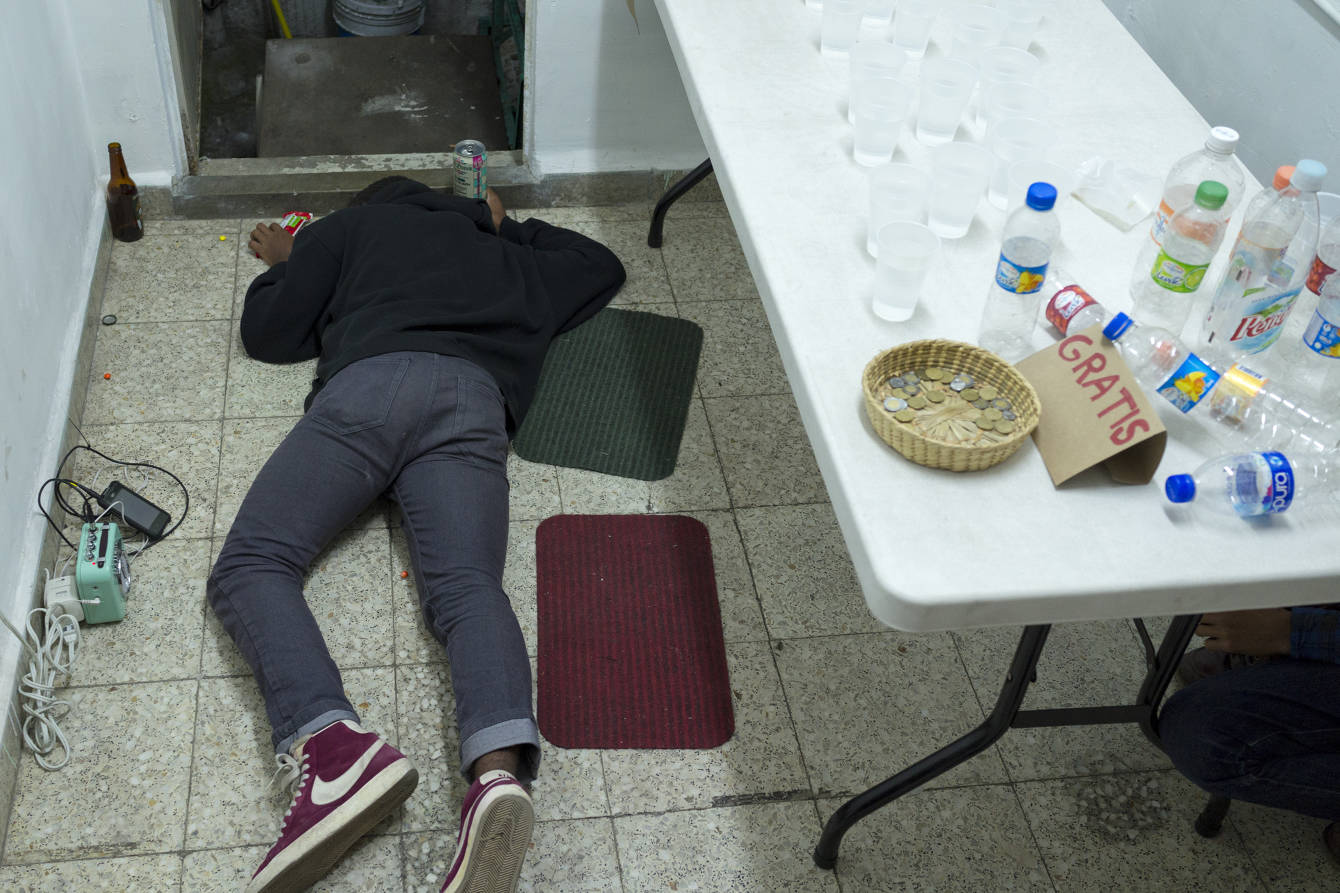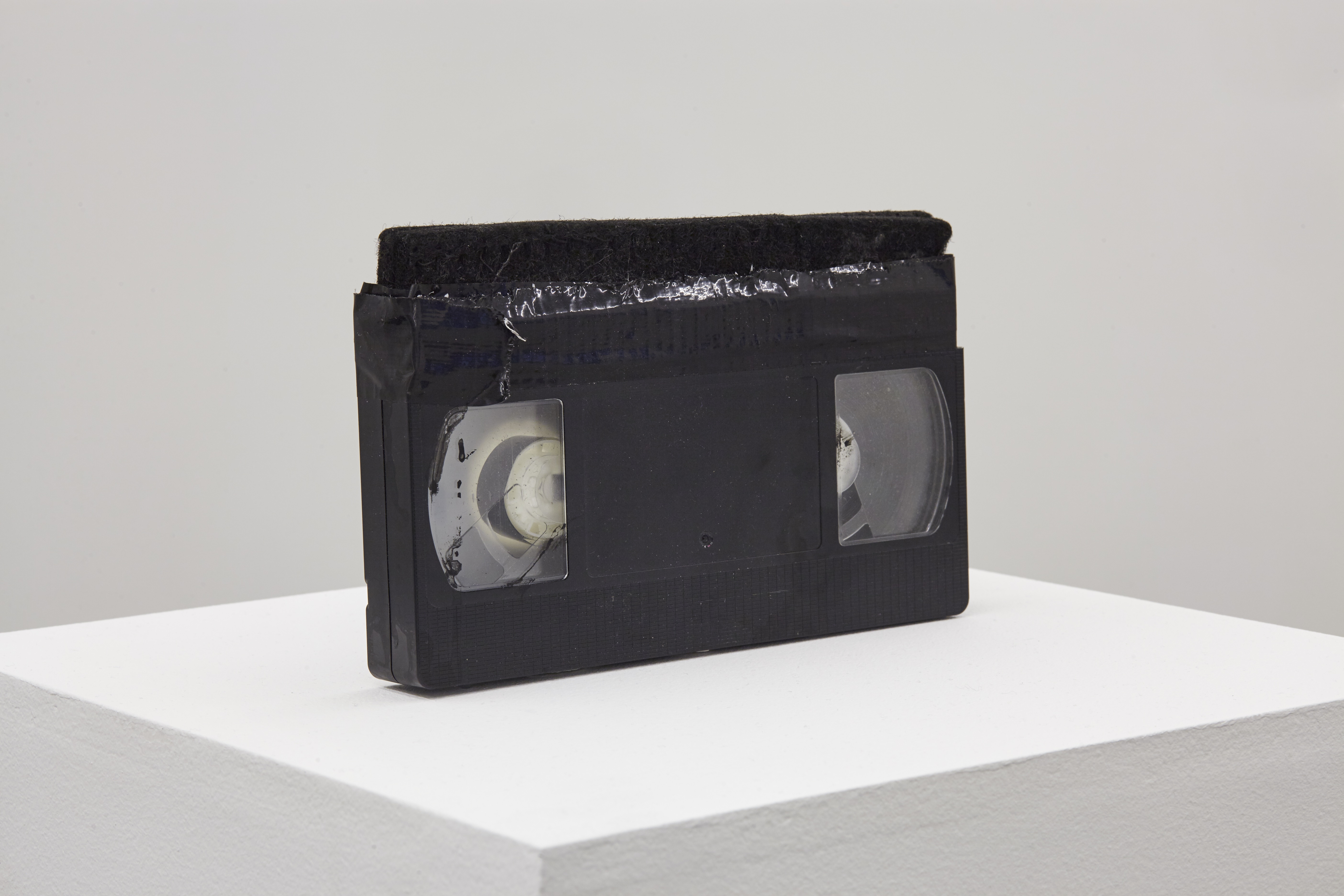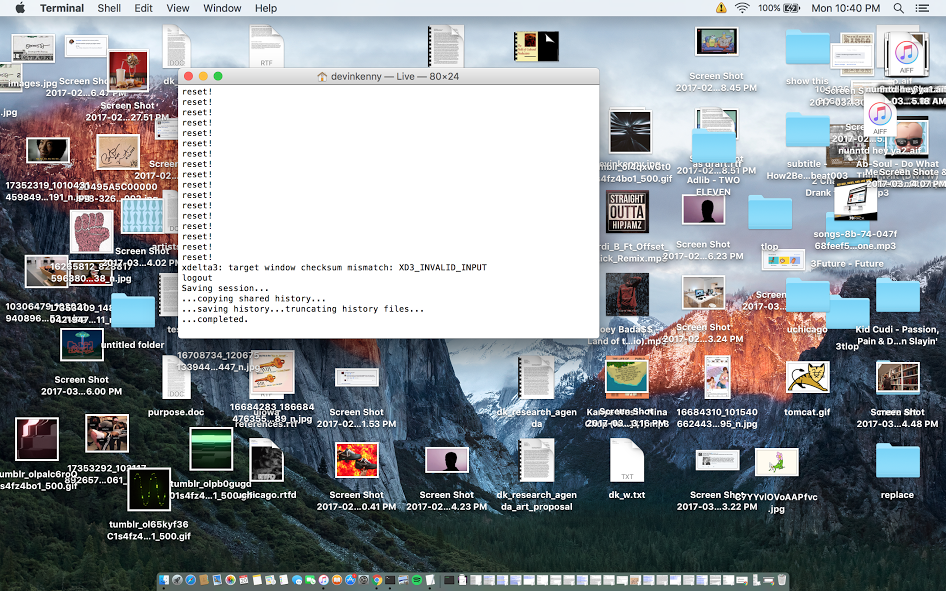The latest in a series of interviews with artists who have a significant body of work that makes use of or responds to network culture and digital technologies.
Sable Elyse Smith: Much of your practice thinks through commodity and distribution as it relates to music and the internet; fissures in intimacy; and systems of control both physical and invisible. In a deft performance work from 2013, Untitled-Clefa, you lay face down on the ground, a bag of Skittles in hand, a few scattered about, beside an Arizona Iced Tea. The image of course is that of the body of Trayvon Martin after his murder at the hands of George Zimmerman.
The duration of the performance is tied to Migos’s “Versace Versace” looped four times, once more than the trinity. I understand that this work was performed in Mexico City. Can you talk a bit about how the work may have shifted or resonated performed in that context?
Devin Kenny: It was in Mexico City at a great space called Biquini Wax right after the miscarriage of justice in the US. I knew that there would be a range of ways to interpret it there, and I knew that the Trayvon Martin case didn't have as much weight there as it did in the U.S. but I did it, one because I refused to feel helpless and upset just because I was isolated as a Black American, and two, because of an experience in Mexico City where I was on the train during rush hour[s] and there was a little boy, no more than twelve who was splayed out on the floor of the train car. People walked around him, stepped over him for multiple stops (I was headed to Preteen Gallery with two friends), and as rush hour closed in, it became more and more crowded, and I noticed he hadn't moved and I was freaking out, asking my friend who had lived in DF for a few years what I should do, thinking I should get off the train, pick up the boy and take him to one of the several police officers in the train station and talk to them (despite their rifles et cetera). His fingers were blackened with something, and I assumed maybe he was a shoe shine boy or something, when my friend said that he was probably passed out from huffing some drug. Finally two tall businessmen walked onto the train and one, needing the standing room, lightly kicked the boy a few times with his wingtip, and he immediately got up, as though from a nap, though with black stains on his nose and lips and groggy eyes. So I felt that even if the Trayvoning meme component wouldn't read there, this prostrate body on the ground would have other kinds of resonances, perhaps more specific to the place. The American audience members talked to me afterwards very teary-eyed, and those unfamiliar with Trayvon Martin afterwards just seemed perturbed that I was blocking the door to get to the roof so long. I sensed many bodies stepping over me for the course of the performance, though my eyes were closed, I could sense the light change and hear the footfalls, some conscientious, others more matter of fact.
 Untitled-Clefa, 2013.
Untitled-Clefa, 2013.
SES: And what is the significance of that juxtaposition: Migos and Trayvoning?
Versace, Versace, Medusa head on me like I'm ’Luminati
This is a gated community, please get the fuck off the property
Rap must be changing cause I'm at the top and ain’t no one on top of me...
—Drake
DK: I was most interested in the way that Drake’s verse opens with lines that, in my mind, echo some of the thoughts of George Zimmerman and the racism of some neighborhood watches, especially as contrasted to the ideas behind community policing as introduced by the Black Panther Party and other groups not satisfied with the lineage of police in America to slave patrols and other forces mostly concerned with the protection and maintenance of “property.” The use of Trayvoning was interesting to me because it was in some ways a response to the viral activity of “planking” but done with a pointedly anti-Black bend. I thought about how people probably made the images of themselves Trayvoning: in a way that brings no harm to themselves, and wanted to extrude that, pick at it, and do something totally different, that might look the same in documentation: privileging the present. I wanted to take the quick, flat, violent, cartoon, and lengthen its duration and maybe in that process let some of the nuance and gravity of that gesture unfurl, so instead of laying down and posing, I actually collapsed while holding the items, and then held the position, body still tensed and muscles burning though in the photo one can’t tell.
SES: And then the significance of music, specifically popular music as a medium. What does it mean or what’s at stake for you when situating these forms of cultural production into the specific art spaces within which some of these performances operate?
DK: It kind of tries to put the institutional atmosphere to the test. If a museum is a space of contemplation, then anything done there will have the privilege of the extended viewing and getting more rigorous attention, including the pop forms which are super sophisticated but almost made to just be felt and held but not unpacked and wrangled with. It’s kind of like that saying about typography, that if it’s done well, the designer is “invisible,” the words on the page are like that because they're supposed to be, and no other way would really make sense. This is not always the case of course, but I think that is the thinking behind a lot of mainstream mass media things: there's a lot put into it but we're not supposed to know exactly what we're agreeing to per se, just agree to it and move on. So the museum space seems to be where the kind of unpacking that would happen on an individual level, or in a small group level, can possibly happen on a group level, in real time. I think that's what I'm interested in.
SES: I’m really interested in the many ways that you use and manipulate voice as a medium. Two elements of your performance practice include musical utterance and lecture. I’m specifically thinking about your performance Love, The Sinner performed at MoMA PS1 on February 28, 2016 as a part of the “Greater New York” exhibition.
How has this gesture of recitation shifted your practice? And what are your feelings about the act of “memorializing” within an art space? Within spaces of contention?
DK: I imagined the crowd would be a lot of older folks who maybe had a connection to the Village, since the topic was dealing with folk music in NYC, so I wanted to be sure that they would hear the reverberations and the continuation of those struggles in the present, whether they were politically active at the time or not. I was surprised and happy that the crowd was actually really diverse in terms of age and race so it could function a bit differently and I think have a greater impact. Starting everything with that list of names would mean something very different if it were only being directed at my peers and contemporaries. The list was Black martyrs of police violence: trans and cis, elderly, adult, teen, child. I really just wanted their names and presences and memories called upon, and acknowledged, in one way seeking a blessing, and in another way trying to redirect some of whatever power I had in that moment to those who had been taken away from us.
It was different in my practice as I do have a history of having very verbose pieces, but usually ones that are more poetic. In this case it was a pretty straightforward list. To memorialize within a space of contention...like all memorial actions can be looked at in a variety of ways, for me, if I could somehow commune with and embolden those that want change by making these names felt (like “say her name”), that’s good, if I upset folks who wanted the formal fun of an “experimental lecture” without social awareness/consequence, that’s also good.

Untitled, 2008.
SES: Can you talk a bit more about your object-based practice in relation to the immaterial labor of the digital structures that you both employ and mimick? I’m thinking here about the works from your 2015 exhibition “Wrong Window” at Aran Cravey.
DK: Sure! I mean the funny thing is it doesn't feel like switching gears or something since I'm always picking up things off the street, sizing things up (that might come from my past in skateboarding), looking at my surroundings: both of my Instagrams (https://www.instagram.com/crashingwavy/ and https://www.instagram.com/6500yearspostseason/) are a lot of that, the latter is more playing with “street style”/“fashion” ideas though. I often talk with peers and in my work about about the ramifications of digital world: social alienation, online beefs turning into deaths, kids trudging through toxic waste dumps to salvage e-waste, the whole conflict mineral issue with Coltan, ain't nothing immaterial about it really, whether we talk about data centers or those giant underwater fiberoptic cables or the concrete impact on people's lives that online activity can have, or click farms, and all these other things, it’s really on the ground and concrete. The immaterial digital labor group has many great folks in it that I learn from all the same. I think part of my interest in that terrain is because telecommunication spaces were really crucial to my coming of age as a ‘tween and teen and beyond that, so being in this kind of transitional group of millennials being teens during the Bush/Patriot Act-era really stuck and I’m sensitive and attentive to the many developments, like: 9/11 happened my first week of high school and we were on AIM what did that mean and are there parallels to be drawn today?

VHS Mop, 2015.
Regarding the objects, for a while I was really big on the idea of making something that looks like it's found, whether that be making things look like a consumer good or making things look like the discarded and disregarded, the kind of “wolf in sheep's clothing” thing: examining an aesthetic we take for granted and trying to flip it somehow. That show “Wrong Window” was jumping off some ideas I had been working on in my last year of grad school and the previous year in the “Made In LA” exhibition (I had a multi-part installation called Alone Together where I was thinking about the parallels between my experience in the Harold Washington Library in Chicago and the kind of sporadic occurrences in the web before 2.0, stumbling on pages, etc.). “Wrong Window” was thinking about a change in culture as traceable through material culture, thinking about “the post” in youth culture as I knew it. Whether that be a post on a Xanga, or LiveJournal, or posting up wheatpaste posters/stapling up fliers, “posting up” as in hanging out with your friends outside in one place (http://www.ndsn.org/summer99/courts3.html) to posting things on social media accounts. So I'm looking at the impetus to become a graffiti king or famous zinester or something in relationship to being internet famous. A friend of mine in high school was in that transition zone in the early ’00s, the local hero with a popular music blog, shout out “indiesnob.” In that show I had t-shirts, print-offs of photos, panels with quotes taken from YouTube comments, concert posters for fictional bands covered in ceramic frit (coming from the practice of smashing a light bulb and mixing it into your wheatpaste, to give would-be censors a rude awakening if they tried to tear down your poster barehanded), mashups of inspirational memes and junk food imagery, yoga mats made of mousepad material or the kind of rubber you use for opening pickle jars, a modified kids’ laptop toy that helped teach spelling, math, et cetera, clear backpacks (references to the tumblr #clear trend and the security measures in urban schools), a graffiti mop made from a VHS tape... lots of stuff.
_i%2C_2015%2C_lenticular_acrylic.jpg)
Selfie mask (stealthie) I, 2015.
Questionnaire
Age: 29
Location: NYC
How/when did you begin working creatively with technology?
I have been having fun with computers since I was in kindergarten in the early 1990s. I have an aunt and uncle that were technology consultants and my aunt worked with databases for law firms and corporate accountants so when I would visit them I could always play games or draw things in MS Paint or make full color photocopies of things. When I was in elementary school I was making little websites...I participated in this thing called Thinkquest for example. In high school I started using FruityLoops (FLStudio) to make beats and I would upload my blip-hop tracks online, this is all that's left...a splash page : http://malfunction.dmusic.com
Where did you go to school? What did you study?
I went to Cooper Union for the Advancement of Science and Art and studied art, with a brief stint at Gerrit Rietveld Academie for study abroad, and after that participated in the burgeoning Bruce High Quality Foundation University in a couple classes while they were a project funded by Creative Time. Shortly after that, for graduate school I went to UCLA for New Genres.
What do you do for a living or what occupations have you held previously?
I'm a shop technician, adjunct professor, guest critic ...
I've been a crew leader for the US Census, a freelance visual merchandiser for Henri Bendel... a copywriter, a file clerk at an office of admissions...
What does your desktop or workspace look like? (Pics or screenshots please!)


